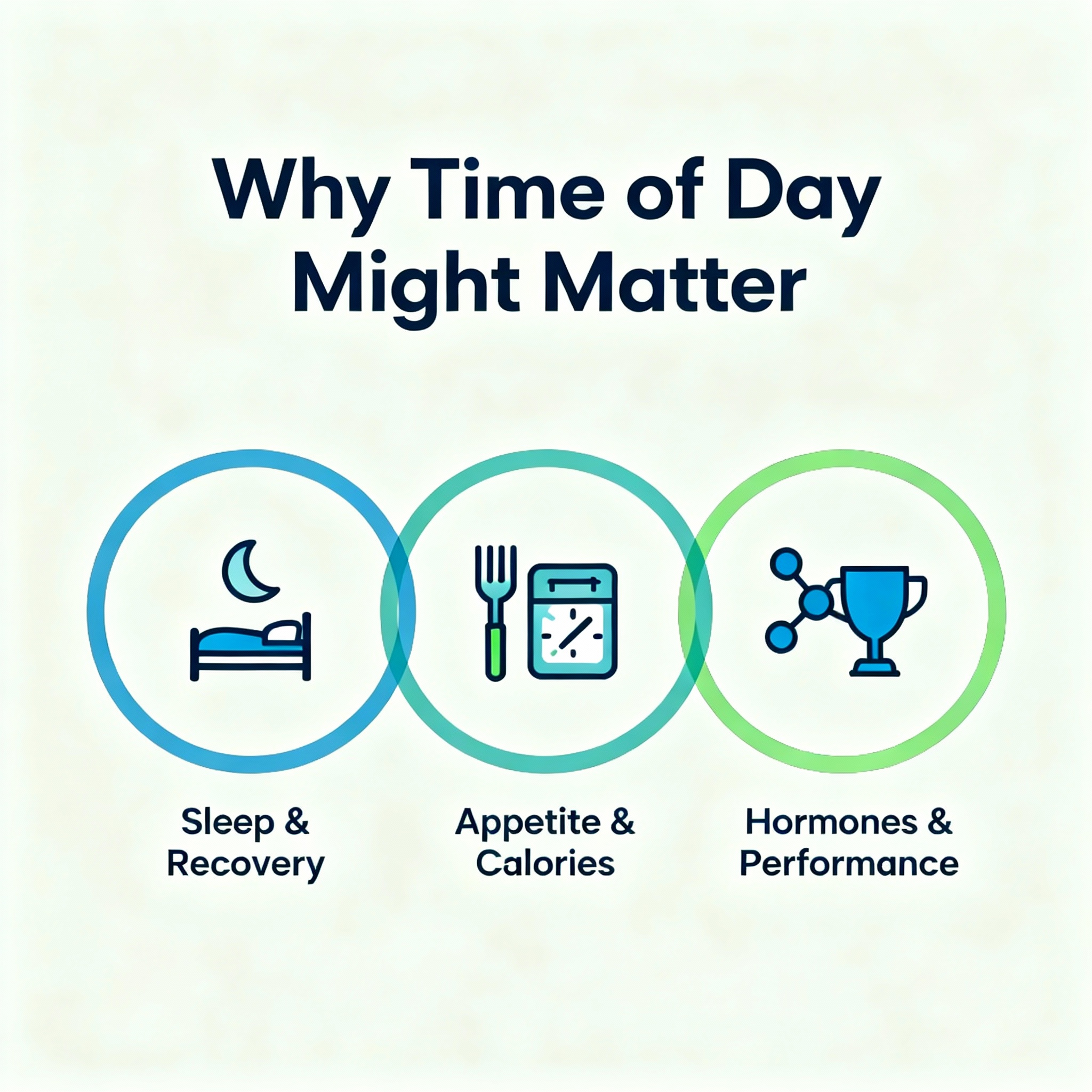People ask all the time whether switching the clock on their workouts will finally unlock faster weight loss. The short answer is, it depends on what you can do consistently, but the science points to a few practical advantages for different times of day. In this article you will learn how sleep, appetite, hormones, and real-world routines change the math, and how to pick the best time for you.
In the sections below I use the phrase best time of day to exercise for weight loss to keep the focus clear, but the most important takeaway is this, consistency and total weekly activity matter more than the exact clock hour you pick.
What the evidence actually says
There are two types of evidence you should know about, observational population studies and controlled trials. Observational studies using wearable accelerometers have found that people who exercise in the early morning, often between 7 and 9 a.m., tend to have lower average BMI and smaller waist sizes than those who exercise later in the day. These papers suggest a link between morning workouts and better weight management, possibly because morning exercisers also eat more consistently and stick to routines.
At the same time, randomized controlled trials, which are stronger for cause and effect, typically show modest weight loss from structured exercise programs and no clear winner for time of day. In other words, both morning and evening exercise can lead to weight loss when the overall volume and intensity of activity are similar.
For practical guidance, public health authorities recommend focusing on total weekly activity. Adults generally need at least 150 minutes of moderate aerobic exercise per week, plus muscle-strengthening sessions twice a week, and more activity often produces greater weight-loss benefits.
Sources to read if you want the papers and guidelines: CDC Physical Activity Guidelines, a randomized trial comparing morning and evening exercise, and a large observational analysis summarized by major health outlets.

How timing influences weight-related mechanisms
Appetite and daily calories
One reason morning exercise is often highlighted is appetite. Some studies show that exercising before breakfast can blunt hunger in the hours afterward for certain people, which may reduce total daily calories. If morning workouts help you eat less during the day, that can boost your calorie deficit.
Hormones and metabolism
Circadian biology affects hormones like cortisol, insulin sensitivity, and even the way your body oxidizes fat during exercise. Some acute studies report higher fat oxidation when people exercise in a fasted state, typically in the morning, but that does not always translate to greater long-term weight loss. What matters most is cumulative energy balance across days and weeks.
Performance and intensity
You may be able to train harder in the late afternoon and evening, because body temperature, strength, and reaction time often peak then. Higher-intensity or longer workouts burn more calories, and better performance can help preserve muscle while losing fat.
Sleep and recovery
If early workouts force you to cut sleep, you can undermine weight-loss efforts. Poor sleep raises appetite hormones and reduces willpower, making dietary control harder. So always weigh timing against sleep quality.
Practical guidance: pick the right time for you
Here are actionable rules to choose when to exercise for weight loss, based on the trade-offs above.
-
Prioritize consistency. Pick a time you can stick with most days, because total weekly minutes matter far more than the exact hour. If that’s 6 a.m., great. If it’s 6 p.m., great too.
-
If you want a small advantage for appetite control, try morning workouts, ideally after a reasonable night of sleep. Some people find fasted morning cardio reduces hunger later, but results vary.
-
If you chase performance, strength gains, or high-intensity intervals, late afternoon or early evening may let you train harder, which can increase total calorie burn and muscle retention.
-
Protect sleep. If early workouts cut your sleep short, move them later, or shift bedtime earlier. No benefit of timing is worth chronic sleep loss.
-
Combine cardio and resistance training. For weight loss and body composition, pairing aerobic work with strength training gives better long-term results than either alone.

Example schedules that work
-
Busy parent, morning slot: 25–40 minutes of brisk walking or interval cardio at 6:30 a.m., 2 strength sessions of 30 minutes on alternate days. Keeps routine consistent before the day begins.
-
Office worker, evening slot: 40–60 minutes of mixed cardio and strength at 6 p.m., focus on progressive overload twice weekly. Eat a balanced pre-work snack to fuel performance.
-
Split approach: Short morning walk for appetite control, plus a 20–30 minute strength session in late afternoon for performance and muscle maintenance.
Addressing common objections
What if I hate mornings? Don’t force it, you will fail to be consistent. What if I can only train late at night? Keep workouts moderate and allow 1.5 to 2 hours before bed for cooling down, otherwise choose earlier if sleep suffers. What about fasted cardio? It can work for some people but has no universal advantage; listen to how your body responds.
FAQs
Is working out in the morning better for burning fat?
Morning exercise can increase fat oxidation during the session in some people, especially if fasted, but that does not guarantee greater long-term fat loss. Total weekly activity and diet have a larger impact.
Will exercising at night stop me from losing weight?
No, evening workouts can be just as effective for weight loss. Consistency, adequate intensity, and sound eating habits determine results.
How many minutes per week should I aim for to lose weight?
Start with at least 150 minutes per week of moderate-intensity activity and two strength sessions. For more significant weight loss, increasing to 225–300 minutes per week often helps, combined with dietary changes.
Should I exercise before or after meals for weight loss?
If you want to manage appetite, exercising before breakfast can reduce hunger for some. If you need to perform at higher intensity, a small pre-work snack or meal is helpful.
Does the time of day affect muscle gain while losing fat?
Training later in the day can favor performance and heavier lifts, which helps preserve muscle. But you can gain or maintain muscle with a consistent resistance program at any time of day.
What do the experts recommend as the single most important factor?
Experts and public health bodies emphasize total activity, intensity, strength training, and sleep over the clock hour. Focus on what you can do consistently.
Where can I read more practical tips and templates?
For writing and content examples that help you plan routines and stay consistent, check the articles on The Marvlus Blog, including practical guides on planning and publishing, and deeper how-to pieces that help you build habits and routines.
Next steps you can take today
-
Choose the hour you can keep for at least 8 weeks, block it on your calendar, and treat it like a meeting. Track minutes, not just workouts, and add two strength sessions weekly.
-
Adjust sleep and meals so the time you pick supports performance and recovery. If mornings make you skip sleep, switch to evenings.
Ready to automate better content and habits?
If you liked the planning and habit tips here, explore more practical articles and weekly content systems at Marvlus. Find templates, scheduling guides, and habit checklists that help you build consistent routines at https://marvlus.blog.
Conclusion
Here’s the thing, there is no single magic hour that guarantees weight loss. The best time of day to exercise for weight loss is the time you will reliably do it, while protecting sleep and supporting a healthy diet. Morning workouts can help some people control appetite, while later workouts can improve performance. Focus on total weekly activity, include strength training, and be consistent. Over time, that combination produces the results you want.
Internal resources you may find helpful: the Marvlus blog homepage for planning ideas, a practical guide on content and routines, and additional posts on building consistent habits in daily life. For evidence-based guidelines on activity amounts and safety, see the CDC and recognized scientific reviews.




